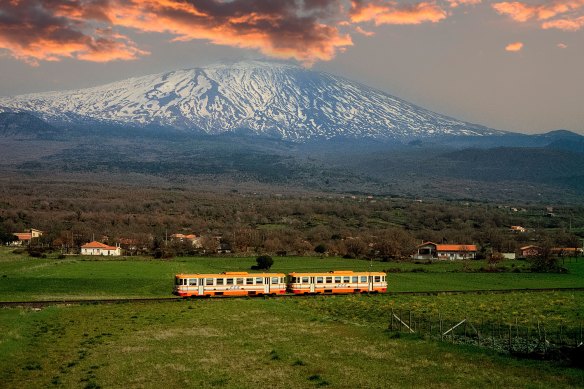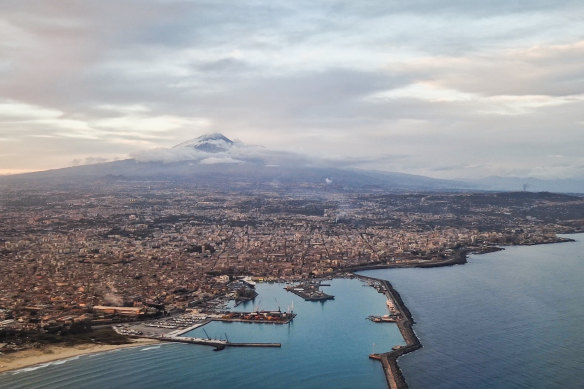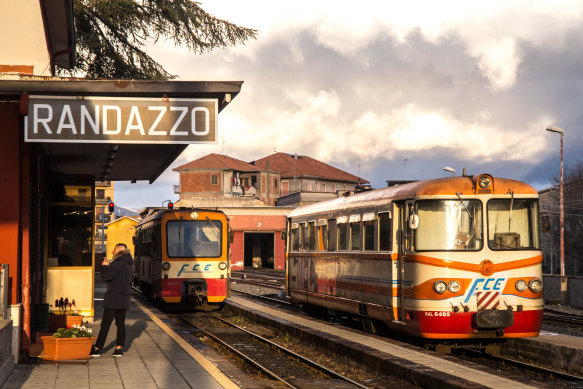The $13 rocky train journey around Europe’s most active volcano
If Sicily’s premier peak could somehow be anthropomorphised, she (or “he”, or even “they”, should you prefer) would surely have long ago been diagnosed with acute behavioural issues.
In the weeks before my arrival on Italy’s largest island, the 3357-metre Mount Etna was pictured puffing contemptuous, almost perfectly shaped smoke rings into the sky like some errant vaping teenager.

The moody Mount Etna and the train that rolls around it.Credit: Alamy
Then by the time I reached Sicily, there was the matter of copious amounts of white powder for the whole world, well, island, to see.
A significant snowfall so freakishly late in the northern spring left even local Sicilians astounded by the sight of the smothered summit of Europe’s most active volcano.
Then, only a few months later, with all of that unseasonal white stuff having melted, Etna, forget the innocuous smoke rings, was back to her most irascible self, wildly expectorating enough lava and ash to make headlines around the world.
On those occasions when Etna is behaving herself (okay, himself), there are the regulation summit tours where tourists can clamber, powder or no powder, above the snowline.
But there’s much more to this World Heritage-listed peak and other, arguably more rewarding, ways to view and experience it which I’m about to discover on a free day on my “Italy, the Deep South & Sicily” Albatross tour itinerary.

Catania and Mount Etna.Credit: iStock
Further down the mountain’s epic slopes exist extraordinary communities which encircle Etna a little like those massive smoke rings, and which are serviced by a rather heroic, if not wholly eccentric, narrow-gauge train.
It’s the Ferrovia Circumetnea, or simply “Round Etna Railway”, a relatively little-known, almost perfectly circular rail loop that has been traversing Mount Etna since the late 19th century.
I’d boarded the train after travelling to one of the Ferrovia Circumetnea stations closest to the glamorous hilltop town of Taormina, notable these days as a location for the streaming series, The White Lotus, and where I’ve been staying as part of the first phase of my tour of Sicily.
The entire journey of the Ferrovia Circumetnea is 110 kilometres long and takes three hours, unless you decide to alight, as you really must, at one or more of the towns and villages along the way. Or you can also simply choose to ride a portion of the line.

The Ferrovia Circumetnea riding its rocky landscape.Credit: Alamy
It’s potluck as to which kind of diesel railcar you’ll end up with, as the rolling stock ranges from aged non-air conditioned and toilet-free carriages from the 1950s or 1960s to more modern-day and much less appealing equivalents with windows that don’t open.
I’m chuffed to have scored one of the former, more characterful, railcars in which a tetchy conductor, moving through the carriage and clipping flimsy paper tickets in the old-fashioned manner, warns me, in no uncertain terms, not to take his photograph.
Indeed, anyone who takes this train expecting some kind of amiable Italianate Rocky Mountaineer will be disappointed.
That said, the ride on the Ferrovia Circumetnea can be rocky, as its railcars lurch and trundle up and around Etna’s foothills, the temperature cooling progressively the higher the train strains and the further it goes from the coast below.
The route passes through salubrious orchards and vineyards, by caramel-coated goats cavorting beside ancient stone walls and fences, between pistachio nut and prickly pear groves and across stark and lumpy lava fields that sprout pockets of technicolour wildflowers.
All the while, a passive snow-capped Etna offers captivating if not teasing cameos from behind the passage of intermittent clouds.
Despite its appeal to tourists, the Ferrovia Circumetnea is by no means a tourist train – its role remains to service the towns and villages that rather bravely exist under this notoriously active volcano.
Yet curious tourists appear to be promoting more trade for the businesses along the line, such as classic Sicilian bars like the one at Randazzo station, where you can step straight from the carriage into the chillier air and be served a stiff espresso and a sticky paper-wrapped pastry within minutes of disembarking.

Stop off at Randazzo station for a coffee and a bite to eat.Credit: Alamy
It’s in scheduled stops such as this one that the Ferrovia Circumetnea delivers a microcosm of authentic Sicilian village life.
Attached to the bar, close to the flow of coffee and grappa, is an annexe, a kind of Sicilian men’s shed, where the town’s local elderly men gather to socialise.
At an altitude of 765 metres, medieval Randazzo, with a population of 10,000, is the nearest town to Etna’s summit. It’s notable for its historical buildings constructed with the local black lava stone, almost as dark as the looks from the conductor back on the train.
Randazzo, built around the three sooty-stoned churches of Santa Maria, San Nicolo and San Martino, is not the highest point of the railway – that distinction belongs to Rocca Calanna, a large sandstone cliff that rises to an altitude of 967 metres further around the line.
It’s difficult to resist the conclusion that these lofty communities are death-defying, as the threat of a catastrophic eruption can’t be dismissed, even though volcanologists are nowadays more accomplished at predicting Etna’s myriad moods.
The eruption of 1971 threatened several villages with its lava flow destroying some orchards and vineyards but no volcanic detonation has ever compared, at least in recorded history, to the peak’s 1669 eruption.
That was when massive lava flows destroyed not only villages in their wake but also the coastal city of Catania, now Sicily’s second-biggest city after Palermo, that’s little more than 30 kilometres below the mountain.
Even to this day, trains that arrive at the city’s railway station cross the site of the 17th century lava flow that reached the city.

Local produce – farfalle with pistachio cream sauce at Gli Antichi Sapori trattoria in Randazzo.Credit: Alamy
Yet the hardy inhabitants of Etna’s perilous foothills balance the inherent danger of living below an active volcano with the benefits of the bounty of produce that the mountain’s rich soils provide to farmers, orchardists and vintners alike.
Among its most cherished produce are pistachio nuts, famed across Italy, that are cultivated around the Etna village of Bronte, half an hour along the rails from Randazzo.
The nuts find their way into everything from gelato to pasta dishes such as the farfalle with cream pistachio sauce served at a fine local trattoria, Gli Antichi Sapori, back in Randazzo.
By mid-afternoon, it’s time to head back down the mountain, and up another one, to Taormina, nowadays full of flashy designer-label boutiques designed to serve the new waves of well-heeled White Lotus-enticed tourists.
As unequivocally lovely as Taormina is – with stupendous unimpeded views of an impeccably behaved Mount Etna benign in all of her snowy glory from the terrace of my hotel – it’s a world removed from the more authentic Sicily I’d encountered aboard the Ferrovia Circumetnea (and I really would have liked a snap of that cranky conductor).
THE DETAILS
RIDE
Tickets for the Ferrovia Circumetnea cost as little as €8 ($13) and are best bought from its stations rather than the confounding online rail company portal. The service, in true Sicilian style, can be as unpredictable as Mount Etna itself, so consult your tour guide or hotel concierge as to the train’s status before you set off. If you’re staying in Taormina, the easiest option is to take a scheduled 45-minute train from Taormina-Giardini station by the coast to Catania Centrale and on to Catania Borgo Station by the local metro where you can connect to Ferrovia Circumetnea. See circumetnea.it
TOUR
Albatross Tours’ 17-day in-depth “Italy, the Deep South & Sicily” fully escorted journey by first-class air-conditioned coach begins in Rome and concludes in Palermo, Sicily with a four-night stay in Taormina. Prices, airfares excluded, from $10,987 a person twin share, including 16 nights’ hotel accommodation, 28 meals and more. Phone 1300 135 015 to book or visit albatrosstours.com.au.
FLY
Emirates flies daily from Australia to Dubai with connections to Rome’s Fiumicino Airport. From Palermo, take a domestic flight to Fiumicino and connect with Emirates internationally back to Australia, via Dubai. See emirates.com
MORE italia.it
The writer travelled as a guest of Albatross Tours and Emirates.
Sign up for the Traveller Deals newsletter
Get exclusive travel deals delivered straight to your inbox. Sign up now.